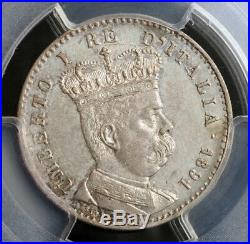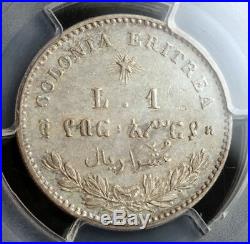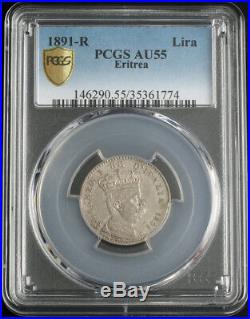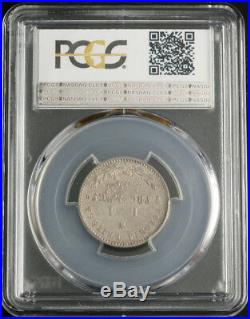1891, Eritrea (Italian Colony), Umberto I. Rare Silver 1 Lira Coin. PCGS AU-55





1891, Eritrea (Italian Colony), Umberto I. Rare Silver 1 Lira Coin.
Mint Year: 1891 Mint Place: Rome Denomination: 1 Lira Reference: Montenegro 85, KM-2. Certified and graded by PCGS as AU-55! 835 Diameter: 23mm Weight: 5gm. Obverse: Crowned and uniformed bust of Umberto I right.
Legend: UMBERTO I RE D`ITALIA. Reverse : Illuminated star above value L. 1 and bi-lingual (Ethiopian/Persian) inscriptions.
Mint initial (R) of the Rome mint below. Officially the State of Eritrea, is a country in the Horn of Africa. It is bordered by Sudan in the west, Ethiopia in the south, and Djibouti in the southeast. The east and northeast of the country have an extensive coastline on the Red Sea, directly across from Saudi Arabia and Yemen. The history of the land that is now called Eritrea, in one way or another, is associated with its coastline on the Red Sea, which extends more than 1000 km.From across the seas came various invaders (and colonizers) such as the South Arabians hailing from the present-day Yemen area, the Ottoman Turks, the Portugese from Goa (India), the Egyptians, the British and, in the 19th century, the Italians. Over the centuries, invaders also came from the neighboring countries of Africa to the south (Ethiopia) and to the west (Sudan).
However, present-day Eritrea was largely impacted by the Italian invaders in the 19th century. This happened in the same year as the opening of the Suez Canal. With the approval of the Italian parliament and King Umberto I of Italy (later succeeded by his son Victor Emmanuel III), the government of Italy bought the Rubattino company's holdings and expanded its possessions northward along the Red Sea coast toward and beyond Massawa, encroaching on and quickly expelling previous'Egyptian' possessions but meeting stiffer resistance in the Eritrean highlands from the invading army of the Emperor Yohannes IV of Ethiopia. Umberto I or Humbert I Italian. Umberto Ranieri Carlo Emanuele Giovanni Maria Ferdinando Eugenio di Savoia.
Humbert Ranier Charles Emmanuel John Mary Ferdinand Eugene of Savoy. 14 March 1844 - 29 July 1900, nicknamed.
, was the King of Italy from 9 January 1878 until his death. He was deeply loathed in far-left circles, especially among anarchists, because of his conservatism and support of the Bava-Beccaris massacre in Milan. He was killed by anarchist Gaetano Bresci two years after the incident.
The son of Vittorio Emanuele II and Archduchess Maria Adelaide of Austria, Umberto was born in Turin, which was then capital of the kingdom of Sardinia, on 14 March 1844. His education was entrusted to, amongst others, Massimo Taparelli, marquis d'Azeglio and Pasquale Stanislao Mancini. From March 1858 he had a military career in the Sardinian army, beginning with the rank of captain. Umberto took part in the Italian Wars of Independence: he was present at the battle of Solferino in 1859, and in 1866 commanded the XVI Division at the Villafranca battle that followed the Italian defeat at Custoza. On 21 April 1868 Umberto married his first cousin, Margherita Teresa Giovanna, Princess of Savoy.
Their only son was Victor Emmanuel, prince of Naples; later Victor Emmanuel III of Italy. Ascending the throne on the death of his father (9 January 1878), Umberto adopted the title "Umberto I of Italy" rather than "Umberto IV" (of Savoy), and consented that the remains of his father should be interred at Rome in the Pantheon, rather than the royal mausoleum of Basilica of Superga. While on a tour of the kingdom, accompanied by Premier Benedetto Cairoli, he was attacked by an anarchist, Giovanni Passannante, during a parade in Naples on 17 November 1878. The King warded off the blow with his sabre, but Cairoli, in attempting to defend him, was severely wounded in the thigh. The would-be assassin was condemned to death, even though the law only allowed the death penalty if the King was killed.
The King commuted the sentence to one of penal servitude for life, which was served in conditions in a cell only 1.4 meters high, without sanitation and with 18 kilograms of chains. Passanante would later die in a psychiatric institution, after torture had driven him insane.
The incident upset the health of Queen Margherita for several years. In foreign policy Umberto I approved the Triple Alliance with Austria-Hungary and Germany, repeatedly visiting Vienna and Berlin. Many in Italy, however, viewed with hostility an alliance with their former Austrian enemies, who were still occupying areas claimed by Italy. Umberto was also favorably disposed towards the policy of colonial expansion inaugurated in 1885 by the occupation of Massawa in Eritrea.
Italy expanded into Somalia in the 1880s as well. Umberto I was suspected of aspiring to a vast empire in north-east Africa, a suspicion which tended somewhat to diminish his popularity after the disastrous Battle of Adowa in Ethiopia on 1 March 1896. In the summer of 1900, Italian forces were part of the Eight-Nation Alliance which participated in the Boxer Rebellion in Imperial China. Through the Boxer Protocol, signed after Umberto's death, the Kingdom of Italy gained a concession territory in Tientsin.
The reign of Umberto I was a time of social upheaval, though it was later claimed to have been a tranquil. Social tensions mounted as a consequence of the relatively recent occupation of the kingdom of the two Sicilies, the spread of socialist ideas, public hostility to the colonialist plans of the various governments, especially Crispi's, and the numerous crackdowns on civil liberties. The protesters included the young Benito Mussolini, then a member of the socialist party. During the colonial wars in Africa, large demonstrations over the rising price of bread were held in Italy and on 7 May 1898 the city of Milan was put under military control by General Fiorenzo Bava-Beccaris, who ordered the use of cannon on the demonstrators; as a result, about 100 people were killed according to the authorities (some claim the death toll was about 350); about a thousand were wounded. King Umberto sent a telegram to congratulate Bava-Beccaris on the restoration of order and later decorated him with the medal of Great Official of Savoy Military Order, greatly outraging a large part of the public opinion.
To a certain extent his popularity was enhanced by the firmness of his attitude towards the Vatican, as exemplified in his telegram declaring Rome "untouchable" (20 September 1886), and affirming the permanence of the Italian possession of the "Eternal City". Umberto I was attacked again, by an unemployed ironsmith, Pietro Acciarito, who tried to stab him near Rome on 22 April 1897.Finally, he was murdered with four revolver shots by the Italo-American anarchist Gaetano Bresci in Monza, on the evening of 29 July 1900. Bresci claimed he wanted to avenge the people killed during the Bava-Beccaris massacre. He was buried in the Pantheon in Rome, by the side of his father Victor Emmanuel II, on 9 August 1900.
He was the last Savoy to be buried there, as his son and successor Victor Emmanuel III died in exile. A newspaper report of Bresci's attack was carried and frequently read by the American anarchist Leon Czolgosz; Czolgosz used the assassination of Umberto I as his inspiration to murder U. President William McKinley in September, 1901 under the banner of Anarchism. The item "1891, Eritrea (Italian Colony), Umberto I.
Rare Silver 1 Lira Coin. PCGS AU-55" is in sale since Wednesday, August 8, 2018. This item is in the category "Coins & Paper Money\Coins\ World\Africa\Other African Coins". The seller is "coinworldtv" and is located in Europe. This item can be shipped worldwide.
- Modified Item: No
- Certification Number: 35361774
- Certification: PCGS
- Grade: AU55
